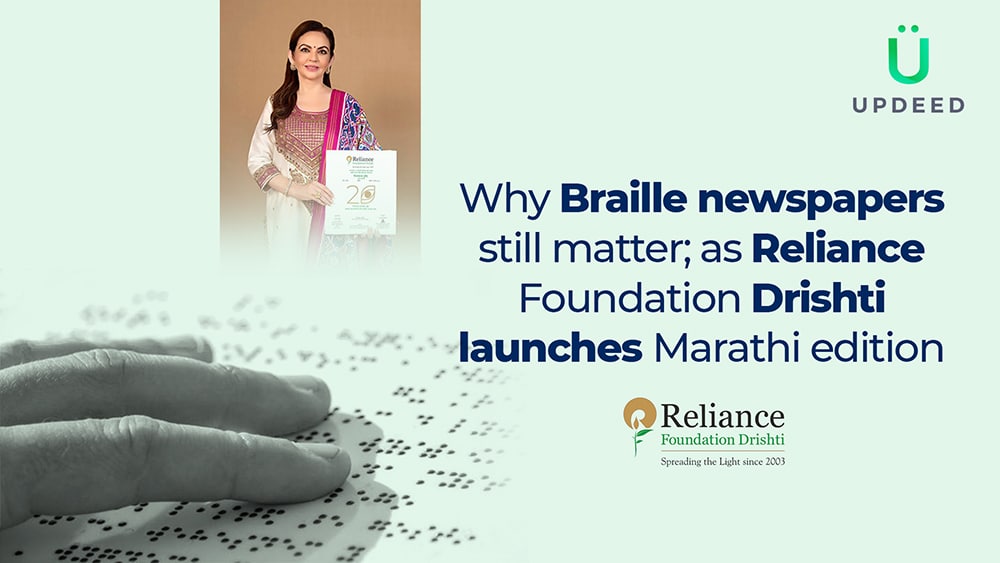Why Braille newspapers still matter; as Reliance Foundation Drishti launches Marathi edition
Recently, Reliance Foundation Drishti started a Braille newspaper in Marathi to celebrate its 20th anniversary. This will be the only Braille newspaper in Marathi that comes out every two weeks in India.
Braille newspapers originated in the early 19th century, when Louis Braille, a blind Frenchman, developed the Braille writing system in 1825 at the age of 15.
The first Braille newspaper was published in 1829 in France, just four years after Braille invented his writing system. The newspaper was called “La Presse ร Bras” and was created by an organisation called the Royal Institution for Blind Youth. The newspaper featured articles about current events, politics, and culture and was distributed to blind people throughout France.

Do we really need Braille newspapers?
According to a report by the World Health Organization, there are currently 284 million people in the world who are visually impaired, and 39 million people are blind.
In many countries, Braille newspapers are produced in collaboration with mainstream newspapers, allowing blind and visually impaired individuals to access the same content as sighted readers. For example, in the UK, the Guardian newspaper produces a weekly supplement called the Guardian Weekly in Braille, available to blind and visually impaired subscribers.
Also, new technologies are being developed to enhance the reading experience for Braille newspaper readers. For example, a Korean startup called Dot Incorporation has developed a smart Braille watch that can display text messages, emails, and news headlines in Braille, allowing blind and visually impaired individuals to access information on the go.
Braille newspapers remain an important means of providing access to information as they provide blind and visually impaired individuals with the ability to read and access information independently. While listening gadgets can be helpful in certain situations, they require a reliable power source and headphones or speakers, which may not always be readily available. Braille newspapers, on the other hand, can be read at any time and place without the need for additional technology.
Braille provides a tactile experience that can enhance comprehension and retention of information. While listening gadgets can provide access to information, some individuals may have difficulty comprehending complex information through auditory means alone. Braille allows for a more immersive reading experience to help individuals with visual impairments better understand and retain information.
Further, it offers a wider range of content and news than what may be available through listening gadgets, which can be limited to certain sources or types of content. Braille newspapers can cover various topics, from news and current events to culture and entertainment, providing a broad range of information to their readers.
Providing Braille newspapers helps to promote inclusivity and equal access to information for individuals with visual impairments, ensuring they are not excluded from the same opportunities and information as their sighted peers.
But assistive technologies are already here?
Despite advances in assistive technologies, Braille newspapers remain an important means of providing access to information, as they offer a tactile reading experience that can enhance comprehension and retention of information.
They serve as an important source of news and information for individuals who are not comfortable or proficient in using listening gadgets or screen readers. provides a broader range of content and news than what may be available through audio sources, promoting diversity and inclusivity.
Moreover, Braille newspapers serve as an important tool for education, allowing blind and visually impaired students to access course materials and stay up to date on current events. In addition, Braille newspapers can provide blind and visually impaired individuals with information on job opportunities, cultural events, and other aspects of daily life that may be difficult to access through audio sources alone.
Overall, Braille newspapers continue to play an important role in promoting independence, inclusion, and equal access to information for individuals with visual impairments, making them a relevant and necessary resource in today’s world.
Ready to make a positive impact in the world?
UPDEED is the place for you. Our free and open platform is filled with inspiring stories from individuals and organizations who are making a difference in their communities and beyond. Connect and collaborate with like-minded individuals from around the globe on UPDEED, and discover your own potential to create meaningful change. Join our community and make a difference.





